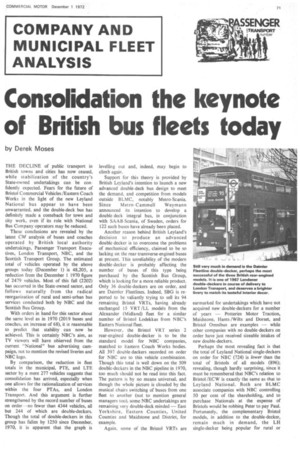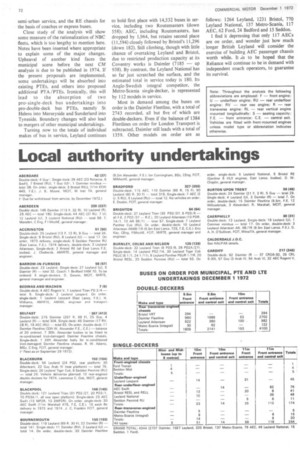Consolidation the• keynote of British bus fleets today
Page 73

Page 74

If you've noticed an error in this article please click here to report it so we can fix it.
by Derek Moses
THE DECLINE of public transport in British towns and cities has now ceased, while stabilization of the country's State-owned undertakings can be confidently expected. Fears for the future of Bristol Commercial Vehicles/Eastern Coach Works in the light of the new Leyland National bus appear to have been unwarranted, and the double-deck bus has definitely made a comeback for town and city work, even if its role with National Bus Company operators may be reduced.
These conclusions are revealed by the latest CM analysis of buses and coaches operated by British local authority undertakings, Passenger Transport Executives, London Transport, NBC, and the Scottish Transport Group. The estimated total of vehicles operated by the above groups today (December 1) is 48,205, a reduction from the December 1 1970 figure of 2479 vehicles. Most of this fall (2202) has occurred in the State-owned sector, and follows naturally from the radical reorganization of rural and semi-urban bus services conducted both by NBC and the Scottish Bus Group.
With orders in hand for this sector about the same level as in 1970 (2019 buses and coaches, an increase of 68), it is reasonable to predict that stability can now be achieved. This is certainly NBC's aim, as TV viewers will have obierved from the current "National" bus advertising campaign, not to mention the revised liveries and NBC logo.
By comparison, the reduction in fleet totals in the municipal, PTE, and LTE sector by a mere 277 vehicles suggests that consolidation has arrived, especially when one allows for the rationalization of services within the four PTAs, and London Transport. And this argument is further strengthened by the record number of buses on order—no fewer than 4344 vehicles, all but 244 of which are double-deckers. Though the total of double-deckers in this group has fallen by 1250 since December, 1970, it is apparent that the graph is levelling out and, indeed, may begin to climb again.
Support for this theory is provided by British Leyland's intention to launch a new advanced double-deck bus design to meet the demand, and competition from models outside BLMC, notably Metro-Scania. Since Metro-Cammell Weymann announced its intention to develop a double deck integral bus, in conjunction with SAAB-Scania, of Sweden, orders for 122 such buses have already been placed.
Another reason behind British Leyland's decision to produce an advanced double-decker is to overcome the problems of mechanical efficiency, claimed to be so lacking on the rear-transverse-engined buses at present. This unreliability of the modern double-decker is probably affecting the number of buses of this type being purchased by the Scottish Bus Group, which is looking for a more reliable product. Only 36 double-deckers are on order, and are Daimler Fleetlines. Indeed, SBG is reported to be valiantly trying to sell its 94 remaining Bristol VRTs, having already exchanged 15 VRT/LL models from the Alexander (Midland) fleet for a similar number of Bristol Lodekkas from NBC's Eastern National fleet.
However, the Bristol VRT series 2 rear-engined double-decker is to be the standard model for NBC companies, matched to Eastern Coach Works bodies. All 397 double-deckers recorded on order for NBC are to this vehicle combination. Though this total is well down on the 509 double-deckers in the NBC pipeline in 1970, too much should not be read into this fact. The pattern is by no means universal, and though the whole picture is clouded by the musical chairs switching of buses from one fleet to another (not to mention general managers too), some NBC undertakings are remaining very double-deck minded — East Yorkshire, Eastern Counties, United Counties and Maidstone and District, for example.
Again, some of the Bristol VRTs are earmarked for undertakings which have not acquired new double-deckers for a number of years — Potteries Motor Traction, Maidstone, Hants /Wilts and Dorset, and Bristol Omnibus are examples — while other companies with no double-deckers on order have just received sizeable intakes of new double-deckers.
Perhaps the most revealing fact is that the total of Leyland National single-deckers on order for NBC (724) is lower than the total of Bristols of all models (896); revealing, though hardly surprising, since it must be remembered that NBC's relation to Bristol /ECW is exactly the same as that to Leyland National. Both are BLMC associate companies with NBC controlling 50 per cent of the shareholding, and to purchase Nationals at the expense of Bristols would be robbing Peter to pay Paul. Fortunately, the complementary Bristol models, in addition to the double-decker, remain much in demand, the LH single-decker being popular for rural or
semi-urban service, and the RE chassis for the basis of coaches or express buses.
Close study of the analysis will show some measure of the rationalization of NBC fleets, which is too lengthy to mention here. Notes have been inserted where appropriate to explain some of the major changes. Upheaval of another kind faces the municipal scene before the next CM analysis is due to be published in 1974. If the present proposals are implemented, some undertakings will be absorbed into existing PTEs, and others into proposed additional PTA /PTEs. Ironically, this will lead to the absorption of two pro-single-deck bus undertakings into pro-double-deck bus PTEs, namely St Helens into Merseyside and Sunderland into Tyneside. Boundary changes will also lead to mergers of other municipal undertakings.
Turning now to the totals of individual makes of bus in service, Leyland continues to hold first place with 14,532 buses in service, including two Routemasters (down 558); AEC, including Routemasters, has dropped by 1,964, but retains second place (11,594) closely followed by Bristol's 11,296 (down 182). Still climbing, though with little chance of overtaking Leyland and Bristol, due to restricted production capacity at its Coventry works is Daimler (7185 — up 938). By contrast, the Leyland National has so far just scratched the surface, and the estimated total in service today is 180. Its Anglo-Swedish integral competitor, the Metro-Scania single-decker, is represented by 112 models in service.
Most in demand among the buses on order is the Daimler Fleetline, with a total of 2743 recorded, all but five of which are double-deckers. Even if the balance of 1384 Fleetlines on order for London Transport is subtracted, Daimler still leads with a total of 1359. Other models on order are as follows: 1264 Leyland, 1231 Bristol, 770 Leyland National, 137 Metro-Scania, 117 AEC, 62 Ford, 24 Bedford and 15 Seddon.
I find it depressing that only 117 AECs are on order, and wonder just how much longer British Leyland will consider the exercise of building AEC passenger chassis worth while. It ,is to be hoped that the Reliance will continue to be in demand with independent coach operators, to guarantee its survival.
































































































































